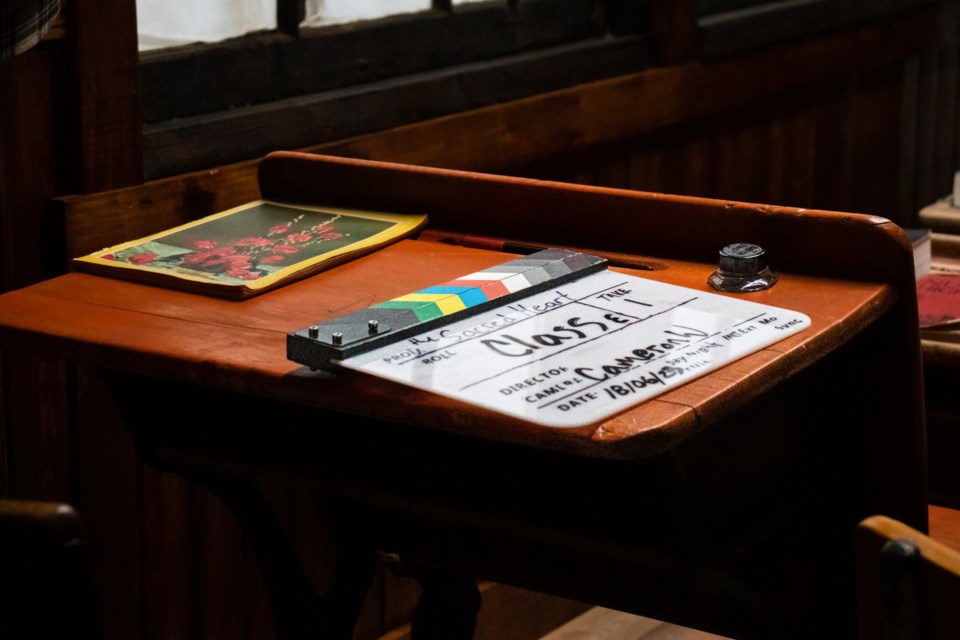ST. PAUL – Passing through multiple exhibits at the St. Paul Museum is a room mimicking that of a school room. Inside the room, an actress dressed as a nun writes on a chalkboard before facing a group of students, as the scene is filmed.
On June 18, the St. Paul Museum was transformed into a movie set for a documentary being filmed by the Acimowin Opaspiw Society (AOS). The scene is among the re-enactments of historical events set when Blue Quills Residential School operated, specifically from 1898 to 1931.
AOS is a non-profit organization based in Saddle Lake, representing the survivors of Blue Quills Residential School. Its mandate includes investigating unmarked burial sites and uncovering historical facts about residential schools. Among the focuses of the documentary is the reenactment of their findings.
Leah Redcrow, executive director of AOS, said the documentary will serve historical, commemorative, and language promotion purposes. The documentary will be bilingual, with English and Cree subtitles, depending on the language being spoken on screen.
Among the early goals set by AOS when it was established was to create a documentary, meant to be another platform to educate people about Indigenous history, including residential schools, said Redcrow. With the documentary, people can see “visually” how complex the residential school system is instead of just reading it.
The documentary involves many Indigenous families and communities, allowing them to tell their stories. “So, there’s survivor stories incorporated into the documentary, [and] there’s the historical narratives written by priests who operated the school,” she said.
These historical narratives are retrieved from the journals of the Missionary Oblates of Mary Immaculate, who operated residential schools throughout Canada, including Blue Quills.
These journals are akin to daily journals, where members of the Oblates write about the everyday ongoings of the Blue Quills First Nation Indian Reserve’s community as well as the residential school, said Redcrow.
The script for the reenactments has been taken directly from the journals. “We didn’t write this... it was written by the priests who were facilitating the whole assimilation process,” said Redcrow. “These reenactments on the documentary basically show people, word for word, these historical events.”
The documentary also aims to answer questions that people may have about residential schools. It will show how people aimed for change, including Chief and Council at the time.
According to Redcrow, the most powerful people in the reserves at the time were the “priests and the Indian agent,” who had more authority than leaders of a reserve. “They controlled everything and then we had the RCMP who would monitor the perimeters of the reserves to make sure nobody left.”
The documentary will also highlight the background history of AOS’ investigative team, their connection to the residential school, as well as findings that have not yet been released to the public.
The release of the documentary is unknown, but the filming wrapped up on June 23 at Saddle Lake’s annual powwow celebration. Editing will take a few months.
Paula S. Apsell is a senior executive producer of the American television series Nova, and also received the Lifetime Achievement Emmy Award from the National Association of Television Arts and Sciences in 2018. Apsell will be involved in the editing process.
While AOS will be releasing “big” documents, such as its preliminary report, “we also want to give people a separate medium.” Those involved hope the documentary can help show others “who we are, why we’re here, why we’re involved, and why we’re doing this.”
The documentary is funded by Heritage Canada, through the Indigenous Languages Component of the Indigenous Languages and Cultures Program.
Investigation reports
AOS continues its investigation of missing children in unmarked burials. Redcrow said many deaths went unrecorded by the government, and explained the importance of working with churches, “because only they would have those earlier records” of the children who died.
For instance, AOS is working with the Roman Catholic Diocese of Saint Paul.
Eric Large, AOS’ lead investigator, said in addition to church records, the investigation team also goes through documents from provincial and national archives to find records of missing children or locate unmarked burial sites.
This includes the over 1,800 pages-long file, c-8703, microfilmed by the Central Microfilm Unit Public Archives of Canada, which can be viewed online at the Library Archives of Canada website.
As far as reports go, AOS will release its next report in January of 2024, and will continue to do so annually. Each report will involve covering a timespan or period of residential school history, right up until 1970. “So, the reports are going to take a long time,” said Redcrow.
The investigations are funded by the Crown-Indigenous Relations and Northern Affairs Canada through the Truth and Reconciliation Commission's Calls to Action 74 to 76.



